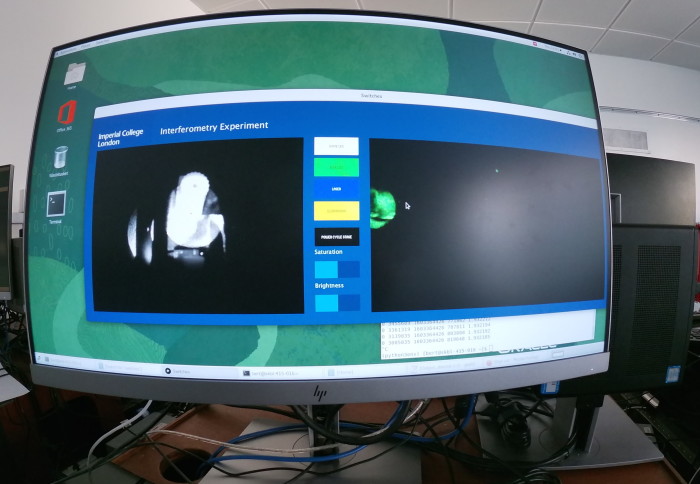Bespoke device allows students to take labs remotely wherever they're based

The app provides footage of the set up via two cameras
The printed circuit board (PCB) lets remote students conduct an experiment in a lab on campus from wherever in the world they’re based, via an app.
Teaching Lab Technician, Ivan Hermida Estornell, from the Department of Physics, has designed a bespoke combination of hardware and software that allows students on the second-year Interferometry course to gather their own data from a lab on campus, even if they’re studying remotely during the COVID-19 pandemic.
“Social distancing means we can’t have as many students in the labs at the same time as we could before,” says Ivan, “and some of our students are working remotely because they’re self-isolating or haven’t been able to come to campus this term. So we’ve devised a way for them to be able to carry out one of their labs completely remotely from wherever in the world they’re based.”
The lab, and its component hardware, is physically based at Imperial’s South Kensington campus, but students can control the devices in that lab remotely via an app from their home computer. They can also monitor changes and results via two cameras that allow them to access live video feeds of the experiment in action and gather the data they need: “it’s like being in the lab, but at home!” says Ivan.
Maximum flexibility
A key aim of the project is to ensure that students get an equitable experience, whether they’re remote and engaging via the app, or undertaking the experiment in-person on campus. The set-up means that they can have greater flexibility and carry out their experiment autonomously – no one needs to be in the lab to monitor or manage the equipment.
“This technology allows students to reset the lab at any point and begin the experiment again if they need to”, says Ivan. “It also means they have access to research grade instrumentation from wherever they are. And they’re all over the world – they could be in China, America, Australia – the remote functionality of the PCB means that the lab can be accessed over a much-extended time frame providing greater flexibility for those working in different time zones.”
The app has been configured to provide footage via two cameras. One camera shows the full set-up as a birds-eye view. The other is located on the fringes, allowing students to focus on what they’re doing and take scientific measurements from a more localised area. “Our plan is to improve the clarity and coverage of the cameras for the next lab cycle,” says Ivan.
Video above shows an example of the interaction a remote student can have with the equipment, via the PCB and app.
The Interferometry experiment
The main experiment requires students to split a single beam of light into two, and then to modify the distance of each path so that when the paths converge into the single beam again, different interference patterns are produced. Analysing these patterns helps students to better understand the nature of light.
The lab has four different set-ups, and sixteen computers. Depending on which computer they are connected to, students will have access to different equipment prepared to perform a varied set of experiments. The PCB is a switcher that allows students to turn different light sources on and off, and also to adjust some of the camera settings.
How do you take a lab and make it remotely accessible?
The project took around two months to design and build. Ivan’s original prototype PCB had two outputs, but the final iteration has five outputs, making it potentially useful beyond the objectives of this specific undergraduate lab.
Experiments can take from twenty minutes upwards, depending on the quality and quantity of data students want to access. “In a couple of hours you could get a really good data set,” says Ivan. “The equipment the students are using is expensive, research-grade equipment, and the data they get from this lab is also research-grade quality.”
In addition to turning certain parts of the device on and off, students can also control other elements, such as the position and angle of the cameras and hardware, and the type of light. “You can switch from one light source to another, depending on the light that you want to analyse in the experiment,” says Ivan, “and measure different things – it’s versatile.”
Video above shows what the students see via the app on their computer at home - here they are moving the linear stage and analysing the data. Fringes are visibly moving.
If the pandemic sees an increase in the need for more flexible approaches to lab research, including remote access, might this kind of application come in useful beyond the remit of education? “Yes, that’s a possibility – the set-up is modular, which means that it’s flexible and has a lot of potential applications beyond this,” says Ivan. “You can connect different hardware to the different outputs – I should imagine it can be used in electronics labs too.”
Innovative teaching in Physics
Ivan also worked with a team on the Physics Labs in a Box project. “It’s been a busy time,” he says, “we’ve been designing a lot of experiments to be done remotely. It’s been quite a challenge, but everything seems to be working fine, so we’re very happy. I really like mechanical designing – you get so much satisfaction designing something that works – especially if it works first time!”
Imperial students have also devised a virtual physics lab that’s set to be used in this term’s teaching.
Interested in studying with us?
Article text (excluding photos or graphics) © Imperial College London.
Photos and graphics subject to third party copyright used with permission or © Imperial College London.
Reporter
Claudia Cannon
The Grantham Institute for Climate Change



